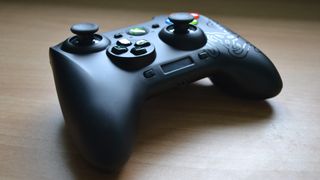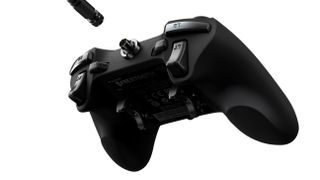TechRadar Verdict
Pros
- +
Amazing extra buttons
- +
Stellar analogue sticks
- +
Integrated programming
- +
Detachable cable
Cons
- -
Serious price
- -
Potential of limited usefulness
Why you can trust TechRadar
Razer's reputation in the PC market speaks for itself. It's a manufacturer that pumps out quality and often left-field kit, including a swathe of keyboards and mice, that generally feature gimmicks that only truly appeal to the most hardcore of gamers.
Gimmicks like adjustable weights, detachable hotkey panels, or mouse resolutions that send reticules flying with only the most microsocopic nudge.
This isn't Razer's first stab at a gamepad - last year's pro-focused Onza pad included analogue sticks with adjustable torsion - but the Razer Sabertooth does something more. This time the key is extra action buttons, between two to six of them, and a pretty advanced on-pad system for customising them.

Let's start from the rear. Mounted in the centre of the Razer Sabretooth's underside is a pair of raised trigger rockers which cover two inputs each.
They're raised so that they can be easily reached with whichever fingers you hook around, and absolutely perfectly placed to replace or augment the standard face buttons when your thumbs are occupied with the analogue sticks.
We fared best using them with index and middle fingers, although their flexibility means it's entirely up to you how you decide to interact with them - or even if you want to use them at all.
Brilliantly, Razer has made the Sabertooth's rear rockers detatchable with an included Torx screwdriver, and even includes silicon covers to fill the void that they leave behind. This is an elite-level pad, and a set of extra buttons (where years of play teaches us there should be empty space) could cause unnecessary distraction.

The other additional buttons sit on top of the pad, between the bumpers and the triggers, slightly towards the centre. They're easy to reach with the tips of the index fingers, even if they're otherwise occupied with the bumpers. Programmable through the on-board OLED screen, all of the Sabertooth's extra buttons can represent whichever digital input you like.

You could map, for instance, X onto the right shoulder, giving you quick access to Halo 4's reload function without having to shift your thumb from the right stick. Or you could map all four rocker switches on the rear to the jump button, just so you've always got it to hand. It's really up to you.
And the Sabertooth stores two different configurations in its internal memory, so you can get your practice in with your ultimate control scheme and get it back instantly wherever you go. There's even a button dedicated solely to profile switching, so it can be done on the fly.
Programming the pad is done with the A & B buttons and the really-rather-good button based D-pad, a realm away from the standard 360 pad and even a step beyond the decent pad Razer included with the Onza.
There's a slight issue, though. The program button which starts the process sits directly below the right analogue stick, and our imprecise sausage thumbs managed to activate it by accident more than once in the heat of gaming. You'll definitely need to adjust your handling at least slightly, although we suppose that's to be expected when transitioning from a standard pad to an advanced peripheral like this.

The box crows about adjustable analogue stick sensitivity, but we couldn't find such an option within the pad. Thankfully the Razer Sabertooth's sticks are perfectly weighted and a joy to use, just slightly stiffer than the standard Xbox pad.
The built-in test mode pips the sticks' full range about a millimeter away from full extension, which is perfect, and there are bright green rubber caps in the box which increase their stickiness at the expense of a little aesthetic beauty.
We should also give mention to the face buttons, an optionally-backlit quartet which Razer calls 'hyper-responsive'. Micro-switched with absolutely minimal travel, they're a great improvement on the Microsoft pad's somewhat spongy inputs.
In fact just about everything - from the detachable braided cable, an absolute must in tournament-level gaming, to the included carry case - puts the Razer Sabertooth on a plane in advance of the standard pad, and we reckon it's probably the best third party pad out there too.

Verdict
So do you need one? It's superior, but it's superior to an already very high standard. If you're not a super-serious competitive gamer, shelling out for the Sabertooth may be entirely unnecessary expense.
We - enthusiastic but resolutely ham-fisted - used it over the course of a month, and while it made our FPS experience slightly more convenient, we're not convinced it led to a positive improvement in skill or result. But your results may vary.
This is an absolutely stellar pad, and it could be the difference between killing and being killed.

